Vintage Treasures: The Night Watch by Sean Stewart
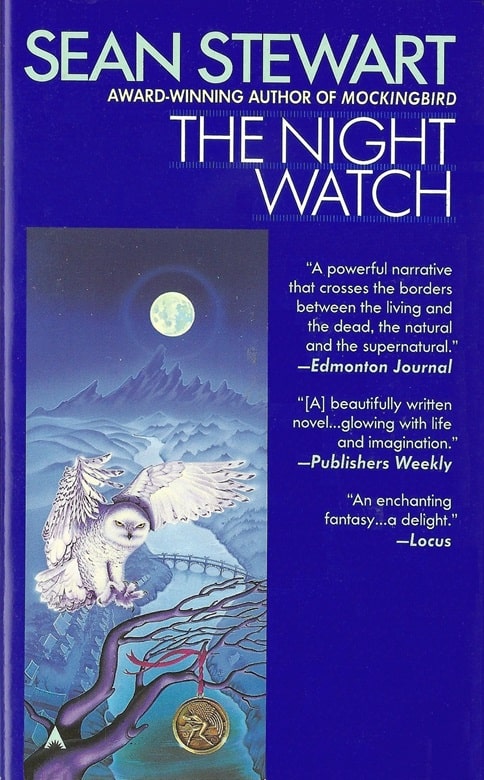 |
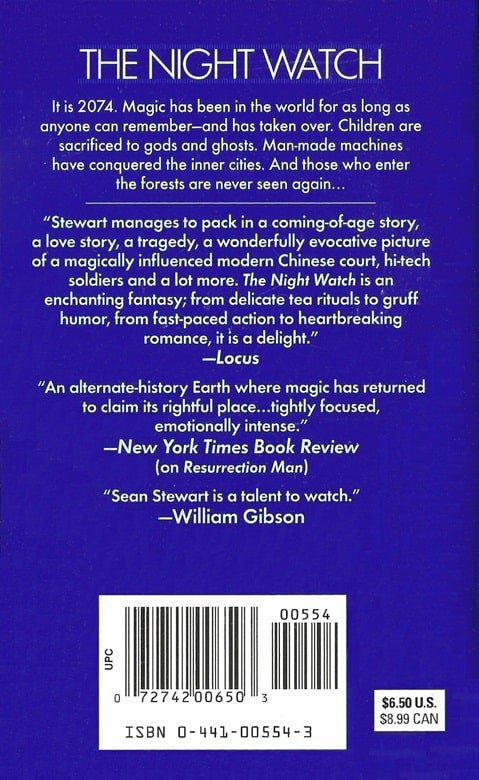 |
The Night Watch (Ace, September 1998). Cover by Tara McGovern-Benson
Sean Stewart has had a fascinating career. He was Creative Director at Microsoft’s Xbox Studios until the studio closed in 2014, then spent five years at Magic Leap. Today he’s a Managing Partner at Cathy’s Book, LLC, publisher of his alternative reality game/novel series Cathy’s Book, and since 2020 he’s been working at a Generative AI stealth start-up as an Interactive Storyteller.
But he began his career the old fashioned way — writing fantasy novels. His debut book Passion Play (1992) won the Prix Aurora Award for Best Canadian Science Fiction novel, and his follow-up Nobody’s Son won the Aurora Award in 1994. His real success came in in 1995 with the appearance of the magic realist fantasy Resurrection Man, The New York Times Best Science Fiction Book of the Year, and the two books set in the same world, The Night Watch (1997) and Galveston (2000), winner of the World Fantasy Award.
The Night Watch is the one I want to talk about today.
[Click the images to watch bigger versions.]
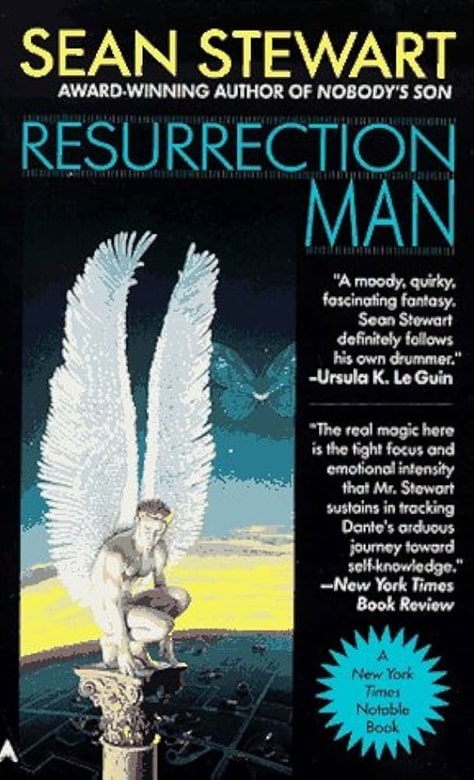 |
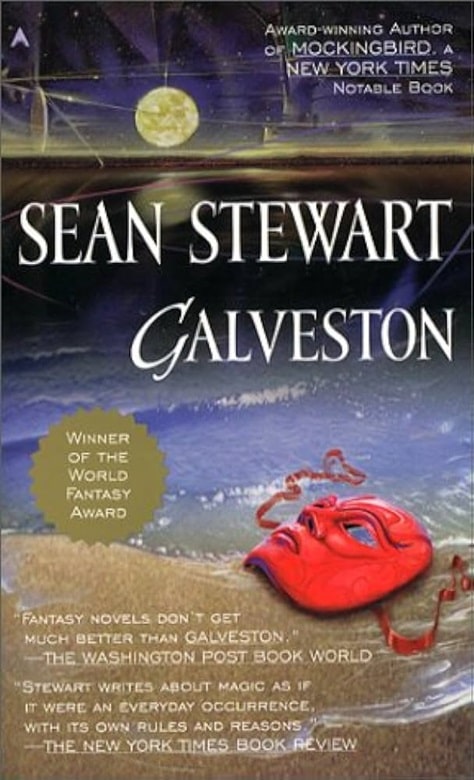 |
Resurrection Man (Ace, July 1995) and Galveston (Ace,
February 2001). Covers by Tara McGovern and Victor Stabin
In 1997 I was running SF Site, one of the first science fiction websites, when I received this enticing review of The Night Watch from Lisa DuMond.
In the world of The Night Watch, magic is a fact of life, and gods, demons, and ghosts abound… What happened to our own century, our own civilization? Gone. Just about everything you and I expect of life has been swept away by the influx of magic and the Dreaming. Huge population centres are a thing of ancient history; the few cities that still exist do so live with a siege mentality. Only two great tribes remain to rule North America.
Southside banished magic and guards the Great Plains with the wizardry of technology. Chinatown maintains the diminished area of Vancouver, surrounded by danger that only the Southsiders can protect them against. A worse allegiance could scarcely be imagined.
In the midst of this escalating chaos, the powerful and the powerless struggle to find a degree of happiness, or, at the very least, stay alive. With gods appearing regularly and mutants pouring forth from the abandoned areas and a sentient forest lying in wait, just living may be too much to ask. Living without fear is certainly beyond the capabilities of most of the survivors…
Sean Stewart… knows writing. His magic is in every carefully laid word and nurtured character. And no one lets that magic flow as he does.
Read Lisa’s complete review here.
Lisa’s article first turned me on to Stewart’s work, and I followed his career closely thereafter. I wasn’t the only one. The next year his novel Mockingbird was nominated for the Tiptree, World Fantasy, and Nebula awards, and in 2004 Perfect Circle received nominations for both the Nebula and World Fantasy Awards.
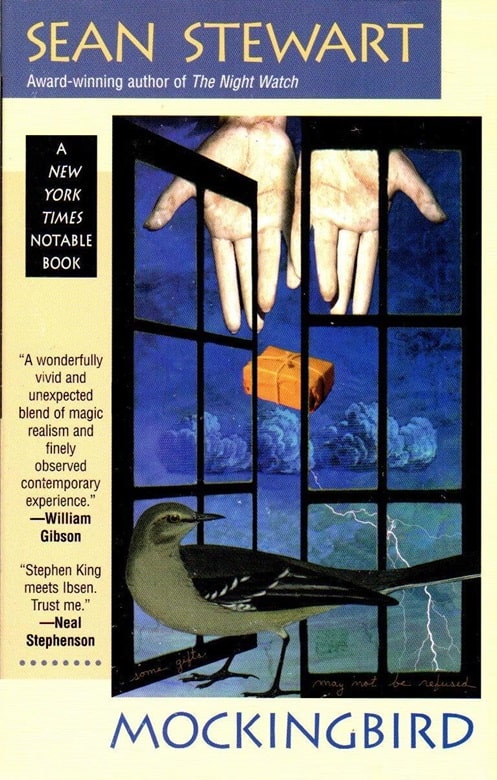 |
 |
Mockingbird (Ace, August 1998) and Perfect Circle (Small Beer Press,
July 2004). Covers by Maggie Taylor and Greg Spalenka
With Perfect Circle Stewart moved from his long-time publisher Ace Books to Small Beer Press, a prestigious small press operated by Kelly Link and Gavin Grant.
Prestigious they may be, but a move like that is a nonetheless a sign that your sales aren’t what a major publisher needs them to be. That same year Stewart published his first media tie-in novel (Star Wars: Clone Wars: Yoda: Dark Rendezvous), and that was his last published genre novel. For the past two decades Stewart has been focusing on his successful gaming career with Microsoft and Magic Leap, and his alternative reality game projects like Cathy’s Book.
His literary career is long overdue for a renaissance, or at the very least a decent retrospective to introduce him to modern readers. And for my money, the place to start is The Night Watch. What’s the novel about? The best plot summary I’ve found from Kirkus Reviews.
A yarn set in the same world as Resurrection Man (1995), where magic has seeped back into the world since WW II and, after a climactic event in 2004, triumphed over and extinguished science — except that, in 2047, advanced computers, engines, and whatnot still work. The South Side of the city Edmonton is relatively magic-free since grandfather Winter literally cut out the magic “angel” growing inside him and sacrificed it to the Powers of North Side in a dreadful Deal. Now his granddaughter Emily must renew the deal, but she refuses and flees to Vancouver, where Chinatown’s leaders have hired troops from Edmonton in order to keep their own magic — generated by monsters — at bay. Winter demands Emily’s return and will supply no more troops until Chinatown complies. Unfortunately, Emily has entered the nearby Forest, a Power that likes Emily and eats troops for breakfast…
The Night Watch has been out of print since 1998, but it has hardly been forgotten. Modern readers have given it a warm 3.8 rating at Goodreads, and readers like Terry still talk about it.
Sean Stewart is one of those writers I used to buy sight unseen (before he unfortunately dropped out of writing novels and decided to devote his time to writing interactive online games). His books tend to be very character driven, something I personally like, and he has an individual writing style that manages to be ‘writerly’ without getting bogged down in stylistic tricks.
Basically it is the story of a future earth in the year 2074 after an inundation of magic has flooded the world (this flood started soon after WWII in Stewart’s timeline) and only pockets of human civilization are left in the sea of wild and magical frontiers (in this the story can be seen as a member of the same universe as Resurrection Man and Galveston). The novel concentrates on two societies, the Southside, which is a relatively technological and militaristic state located where Edmonton used to be and Chinatown, located in the appropriate region of Vancouver. The former community has made a Faustian deal with the spirits that haunt the Northside in return for the opportunity to be left alone, while the latter lives in the midst of its spirits, especially the three godlike, and archetypal, beings the Dragon, the Lady and the Monkey and the beastlike barbarians (magically mutated humans from the initial magical explosion)…
Stewart manages to populate his world with many interesting, and realistic, characters. None of them are painted in black-and-white terms and even the ‘villains’ have realistic motivations that point to a multi-faceted melding of both self-interest and even love of community. The real star of the book for me, though (even with Stewart’s finely realized and well-drawn characters) was the world itself. It is a world we can recognize, and yet at the same time it is completely alien. The small enclaves of humanity fighting for survival in a world that can barely be understood… In many ways I felt that Stewart had managed to capture the air of the medieval romance (in terms of world-building if not in style or content) with the minor ‘kingdoms’ of humanity placed in the midst of the ever encroaching ‘wild wood’…a place where demons and ghosts walked and adventures or power might be bought, though at a very high price…
The Night Watch is a great book. It’s a well-written story of human relationships set against a backdrop of conflict and magic in a world that could almost, but not quite, be our own.
Read Terry’s complete review here.
Someone with a stellar career like Stewart rarely returns to the low-pay, low-attention world of genre publishing, but those of us who remember the excitement each of his novels generated three decades ago still hold out hope. In the meantime, his body of work still waits to be discovered by modern readers.
The Night Watch was published in hardcover by Ace Books in November 1997, and reprinted in paperback in September 1998. It is 339 pages in paperback, priced at $6.50. The cover is by Tara McGovern-Benson. There is no digital edition.
See all our recent Vintage Treasures here.
It’s interesting that so much of the discussion and several of the reviews of Stewart’s work talk so much about the world he builds, if the stories themselves are so character-driven. Is it coincidence? Or is it more that the characters capture the attention for the duration of the reading, and the setting is what makes the books enduringly memorable?
(Rec. RoG EEggs increased to 2.)
I thought Stewart’s early novels were wonderful, and then he disappeared. I didn’t realize for a long time that he was doing gaming work. As I’m not a gamer, it feels like a loss to me — but I respect it in theory, and if it’s what he wants to do with his career, more power to him.
He’s also one of several quite talented Canadian writers who seem to spend a lot of time in the US — as with, cough cough, a certain Todd McAulty. 🙂
But also: Robert Charles Wilson, Cory Doctorow, John Clute, Geoff Ryman, S. M. Sterling, etc.
To be sure, in the other direction there are the likes of Spider Robinson, William Gibson, Charles Saunders, Donald Kingsbury, Chan Davis …